The road home starts here
November 16, 2012

Children, families and veterans are among the more than 50,000 people living on L.A. county's streets.
As Thanksgiving approaches and we gratefully count our blessings, we also reflect on those who are consigned to society’s sidelines, living without roofs over their heads and cut off from the comforts of home and family.
They include, in our county alone, thousands of veterans, thousands of young people and families, thousands with physical disabilities and tens of thousands more who are mentally ill.
Reducing their numbers is our moral obligation, a responsibility we all share. Within Los Angeles County government over the course of the past year, we’ve taken that responsibility to heart and created something unprecedented to set us on the right course.
For the first time, we’ve brought together all the diverse departments with a role to play in preventing and ending homelessness and combined them into a powerful and dynamic force—the Los Angeles County Interdepartmental Council on Homelessness.
On November 15, the council’s initial year of work culminated in our adoption of the county’s first-ever roadmap for addressing homelessness. This roadmap taps into the collective wisdom, expertise, street smarts and tactics of more than a dozen departments and establishes how each will play a role in finding solutions and aiding those who so desperately need it.
It’s intended to cut through bureaucratic obstacles and focus on results, including more permanent supportive housing, better data sharing and teams that will work across departmental lines to provide services and leverage available funding for maximum impact. Proven, money-saving successes like Project 50 can become models for a countywide “housing first” approach.
But a roadmap is just that—a guide to where we’re going. It’s only as good as the drivers behind the wheel, and clearly, there will be many detours, off-ramps and obstacles to navigate before we reach our destination.
In other words, as challenging as it was to create, coming up with the roadmap was easy compared to the daunting journey that lies ahead.
As I’ve said before in this space, and no doubt will again, homelessness remains a great stain on our society. For a country as rich and well-endowed as ours, it is shameful and inexplicable to have so many of our fellow citizens sleeping out on the streets each night, including children, families and veterans who have answered the call of service to our nation.
We owe them better. With more than 50,000 homeless people counted on our streets last year, the need for action and for true, lasting results is immense.
It is our time—and our obligation—to do something big.
We’ve got the map. Where we go from here is up to us.
Posted 11/16/12
Expo work keeps on rolling
November 16, 2012
Construction on the second phase of the Expo Line will continue moving ahead while a legal appeal of the project’s environmental process is pending, the California Supreme Court ruled this week.
The homeowners group Neighbors for Smart Rail had asked the state’s high court to halt work on the light rail line until its appeal could be decided. The group’s lawsuit challenging the project’s environmental review previously has been rejected at both the state trial and appellate court levels.
The initial segment of the Expo Line is now running between downtown L.A. and Culver City and is attracting record numbers of riders. Construction on the $1.5 billion second phase of the line, which will run to Santa Monica, is now underway.
“This decision preserves thousands of direct and indirect jobs just when our local economy is slowly starting to recover,” said Supervisor Zev Yaroslavsky, who also serves as chairman of the Expo board. “At the same time, it keeps our efforts to build a modern transit system on-track.”
Earlier, Yaroslavsky and other officials had expressed deep concerns about the potential of a court-ordered delay in construction, which they said would not only eliminate jobs but also contribute to costly delays.
When completed in 2015, the Expo Line, paralleling the heavily congested 10 Freeway, is expected to make it possible to travel between downtown L.A. and Colorado Avenue and 4th Street in Santa Monica in 46 minutes.
Posted 11/16/12
This Thanksgiving, less can be more
November 16, 2012

The turkey's stuffed, but you don't have to be. The director of Public Health has tips for taking it easy at the table.
So your belt buckle is loosened, your appetite is whetted and your fat pants are pressed and ready to go. But for all you pilgrims who yearn for a Turkey Day that, just once, could go easier on your waistline, Los Angeles County’s director of public health has a gentle suggestion:
“Choose less,” says Dr. Jonathan E. Fielding. “Thanksgiving isn’t just about the meal.”
Fielding’s advice echoes the motto of the recent Department of Public Health campaign to educate Southern Californians about portion control. Most adults only need 2,000 calories a day to remain healthy, and most children require even fewer. But many Americans bust that caloric budget and then some on Thanksgiving, typically packing 2,000 to 5,000 calories into a single meal, says Fielding.
“This is a day when it’s not surprising to see somebody go a little crazy,” he says. “There are, however, a couple of things you can do that may be palatable.”
Try to have an active morning. “Do a little extra exercise,” Fielding suggests. A 30-minute jog (about three miles) will work off about six ounces of turkey. Sixty sets of 10 Burpees, and it will be as if you never ate that cup of mashed potatoes and gravy. And if you get really ambitious, 20 minutes on the stairs or Stairmaster will dispense with a slice of pumpkin pie.
Don’t hit the table on an empty stomach. “Eat a piece of fruit or a handful of nuts before heading out to your gathering,” Fielding says. “Or drink a couple of glasses of water to give yourself that feeling of fullness.” Being less hungry will help you avoid overeating when you sit down to the main meal.
Set the table with smaller dishes. Use plates that are 8-10 inches for adults and 6-8 inches for kids, Fielding says. It helps your guests control their portions, and acknowledges the tendency of most people to clean their plates, even if they already feel full.
Take the serving dishes off the table. “When food is in front of us, we tend to eat it,” says Fielding. “So put the serving dishes on another table, or in another room, where you’re not looking at them.”
Start with small portions. “Just serve yourself two to four bites of whatever looks good,” Fielding suggests. “Eat slowly, and give your body a chance to enjoy what you’ve swallowed. Give yourself 20 minutes, and then, if you’re still hungry, go back.” Remember that standard portions of most foods are much smaller than the super-sized menus doled out in restaurants, and an ideal plate should be half vegetables and fruit. (Click here for a good primer.) A standard serving of poultry is 3 ounces, about the size of a deck of cards; a standard serving of mashed potatoes should be about the size of a tennis ball.
Hydrate. Water is one of the best beverages around, Fielding notes, and, for a Thanksgiving dinner, sparkling water couldn’t be more elegant. Even if you’re serving wine or cider, make sure it’s on the table as an alternative.
Please don’t serve sugary sodas, especially not to the kids. Q: What has the equivalent of 22 packets of sugar in it, and more calories than a second helping of stuffing? A: A 20-ounce bottle of regular Coke. Fielding says that, of all the efforts Americans make to keep their weight down, just three simple changes would make a world of difference. “Choose less, increase physical activity and reduce your intake of sugar sweetened beverages.” A single serving a day of sugar-sweetened beverages increases a child’s risk of obesity by 60 percent.
Embrace leftovers—but not for too long. Leftovers, of course, are one of the best things about Thanksgiving dinner. They’re also a good way to talk yourself out of overeating. Have your guests bring their own takeaway containers. Or, if you’re a guest, think about setting aside part of your meal to take home and eat later. Just remember that food shouldn’t sit out for more than two hours, says Fielding. Unlike fat pants, “leftovers don’t have an infinite life.”
Posted 11/15/12
Seeing stars in rural Los Angeles
November 14, 2012
Welcome to the dark side, Los Angeles County. This week, the Board of Supervisors officially cracked down on light pollution in the county’s rural areas.
Long awaited by unincorporated communities in the Antelope and Santa Clarita valleys and the Santa Monica Mountains, the county’s new “Dark Skies” regulations—approved earlier this year, but delayed to hammer out some technical language—mark the county’s first comprehensive effort to restrict outdoor lighting in sparsely populated parts of the county where the sight of the Milky Way at night is as cherished as ocean views are to beach dwellers.
“One of the primary complaints we get from residents is urbanites coming out into their rural communities and brightening their acreage,” says Bruce Durbin, supervising regional planner for ordinance studies with the county Department of Regional Planning. “People understand that there are natural resources to protect, and even in an urbanized county like Los Angeles, there are still rural areas where people want to live that rural lifestyle, and the night sky is a defining element of that.”
The new regulations, which take effect December 13, create a Rural Outdoor Lighting District that encompasses not only the Santa Monica Mountains and the rural areas in the northern part of the county, but also much of Catalina Island and rural unincorporated areas in the East San Gabriel Valley around Rowland Heights and Diamond Bar. (For a map, click here.)
Within that area, outdoor lights will have to be shielded so the light faces downward and doesn’t “trespass” on neighboring properties, and output will be mostly limited to 400 lumens, or about as bright as a 40-watt incandescent bulb. Most commercial and industrial lights will have to be turned off between 10 p.m. and sunrise, and recreational facilities will be encouraged to use high-pressure sodium or metal halide lamps to keep glare down.
Jails, prisons, probation camps and other such secure facilities will be exempted, as will sites such as marinas, aviation facilities, theme parks and petroleum processing plants, which require security lighting. However, most properties—including the county’s—will be covered, although existing street lights will be dimmed only as they’re replaced.
The goal, Durbin says, is to keep the glare from eclipsing the night sky and confusing the nocturnal wildlife that rely on the dark to find their way. The regulations will also bring uniformity to unincorporated communities, many of which had localized outdoor lighting standards that were vaguely worded or unenforceable.
Property owners will have until June, 2013, to come into compliance, says Durbin, although those who want to get a jump on the new rules can click here for this useful interim guide. Official brochures will be available in January at county field offices, libraries and public information counters at the Department of Public Works and Department of Regional Planning, he adds.
Light “trespassers” will have six months from the date of notification to dim their lights. If a light is too bright for the law, but the glare doesn’t “trespass” onto someone else’s property, the grace period could last for as long as three years, he says.
The regulations will be enforced by county planning and zoning inspectors, who will use photometers to measure light trespass complaints. To file a complaint, residents can contact the Department of Regional Planning Zoning Enforcement at (213) 974-6453 after December 12, or dial the County Helpline 211.
Rural Angelenos applauded the measure.
“If the ordinance works as intended, we’ll keep our night skies and views of the stars, owls and other nocturnal hunters will still be able to find their dinner and some of our neighbors can finally get rid of their bedroom blackout curtains,” says Mary Ellen Strote, a longtime resident of the Santa Monica Mountains.
“A lot of us have been waiting for this ordinance since the 1970s, when people started bringing ‘city’ lighting into the mountains. It’s a real gift to the county’s rural residents.”
Posted 11/14/12
Some post-election reflections
November 8, 2012
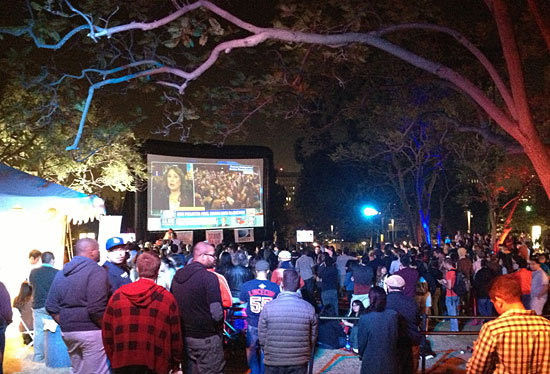
An election night crowd gathers to watch the returns in Grand Park, outside the county of Hall of Administration.
As Churchill once said, “Democracy eventually does the right thing, but only after exhausting all of the alternatives.” The same could be said of California voters, a group that’s a lot smarter than the “political experts” give them credit for.
This year they largely got it right.
Thanks to them, the state of California has taken a step back from the financial precipice. By approving Proposition 30, voters helped California take a giant step toward stabilizing its finances. Failure to do so threatened every service the state provides, starting with education. Now, California and its citizens can catch their collective breath.
Voters’ passage of Proposition 39, meanwhile, plugged a loophole that allowed California companies that do business outside the state to avoid taxes here. Now, those companies will have the privilege of paying taxes like the rest of us. And the funds that will be captured as a result will further help stabilize California’s finances.
And in rejecting Proposition 32, the California electorate saw through the measure and recognized that it is inherently unfair to allow conservative, multiple-million dollar PACs to fund elections while preventing their labor counterparts from leveling the playing field.
We had a disappointment on County Measure J, which would have extended the ½-cent sales tax to allow the MTA to accelerate construction of mass transit and highway projects that were previously approved by county voters. Measure J came within less than two percentage points of the required 2/3 vote, but it didn’t quite make it. It’s a disappointment to me because we had the opportunity to take advantage of record low interest rates and construction costs that would have allowed us to build out our transit infrastructure in 12 years, instead of 30. Now we will remain stuck with a 30-year schedule which will undoubtedly cost billions more as interest rates and construction costs rise over time.
Finally, on a personal note, I will be very sorry to see our San Fernando Valley Congressman Howard Berman leave office at the end of the year. He has been one of the most outstanding members of Congress for the last 30 years. Howard has been one of the most respected Congressional voices on foreign policy, immigration and other important issues facing the nation. He was also a great representative for the Valley and Los Angeles County. He will be sorely missed. However, I have a feeling we haven’t heard the last of him yet.
Overall, voter participation was lower than it was in the last Presidential election of 2008, and that was disappointing. As President Obama said on Tuesday night, there are people all around the globe who risk their lives for the right to vote, but here at home, too many of us take that right for granted. To those of you who did your part, regardless of how you voted on the candidates or the ballot measures, thank you. Our democracy can only work if we all participate. And that participation is not just a quadrennial exercise, but in truth must be a year-round commitment.
Posted 11/8/12
Honor veterans? Let us count the ways
November 8, 2012
This Veterans Day weekend, you can pause quietly to honor those who served—or jump on your Harley and take a ride with a difference.
From a “Ride for Her” motorcycle event honoring women veterans in Long Beach to a traditional parade in the San Fernando Valley to Malibu’s annual ceremony in Legacy Park, the Sunday calendar is full of possibilities. Other events—including a ceremony at McCambridge Park in Burbank—take place on Monday, the day after the holiday, when government offices will be closed.
This list, assembled by the county’s Department of Military and Veterans Affairs, includes more events along with an array of special offers for veterans.
Posted 11/8/12
Poll work’s all in the (county) family
November 8, 2012
It was closing in on 10 p.m., and Russ Guiney had an after-hours drop to make in a church parking lot in Arcadia.
While his day job involves running the county Department of Parks and Recreation, on this particular evening Guiney was helping to transport precious cargo—ballots from one of the county’s 4,621 polling places—to the trucks waiting to take them to their final destination, the Registrar-Recorder’s office in Norwalk.
It takes an army to put on an election in a county as vast as Los Angeles, and many of the foot soldiers are county employees.
On Tuesday, 3,946 of them—from clerks to department heads—marched into action as voluntary poll workers, part of a larger group of 27,000 community and student workers needed to pull off a presidential election in which more than 2.3 million county residents cast ballots.
If you voted on Election Day, chances are you ran into one of them. Maybe they provided a tutorial in using the InkaVote machine—or even gave you a round of applause.
“A lot of the memorable moments came from the first-time voters who came in,” said Reggie Tuyay, a recreation service supervisor at Whittier Narrows Recreation Area who worked a polling place in South Pasadena on Election Day. “One of the things our table did is we started applauding the first-time voters.”
County workers must get approval from their supervisor in order to participate. High-ranking managers are required to take part or to recruit 5% of their workforce to do so. Everyone receives their regular county pay for the day, in addition to a stipend ranging from $105 to $175, depending on their assignment.
And there are some rewards that go beyond the financial.
“It was my first time doing it, and I really enjoyed it,” said Analie Pitallano, who ordinarily works as a victims’ advocate in the District Attorney’s office. “I loved seeing immigrants who’d just become citizens come in to vote. It was just so great. Parents brought in children to show them the process.”
It’s not a cushy job—at least as far as the hours are concerned, with workers arriving before polls open at 7 a.m. and staying after they close at 8 p.m. to inventory the ballots and pack them up, along with the election equipment.
“When we got out at about 8:45, we found out that Obama had already won,” Pitallano said, who nevertheless said she’d happily do it again, in large part because of the interactions with the voting public.
“It was a long day, but I met so many people,” added Annie Luong, an administrative support staffer in Health Services.
“If you’re a people person, this is the job for you,” said Jacklyn Jorge, the program’s coordinator.
For the Registrar-Recorder’s office, bringing in county employees—under a program established by the Board of Supervisors in 2001 to combat chronic shortages of poll workers—has become an important part of staging elections across a sprawling territory.
“I think it’s become an essential part of our process because the county is so large,” said Registrar-Recorder/County Clerk Dean Logan.
It also provides a large pool of county-affiliated election observers. “It gives us the opportunity to hear from the county family what is going on out there,” Logan said.
And sure enough, the day after the election, department heads including Santos Kreimann of Beaches and Harbors, who’s currently serving as acting director of the county Assessor’s Office, were coming up to Logan to share what they’d seen.
Kreimann and Guiney, the head of Parks and Recreation, both said they welcomed a chance to spend a day working on the front lines of democracy—and getting the change in perspective that goes along with it.
“I enjoyed it, actually, because I wasn’t in charge,” Kreimann said.
Posted 11/8/12
Life in the ExpressLanes
November 1, 2012
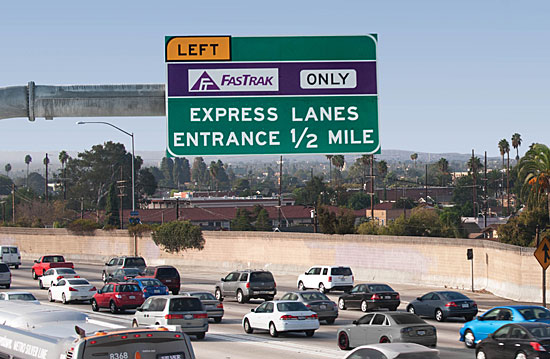
The ExpressLanes project promises, at least temporarily, to change commuting as we know it on the 110.
In the city known for its freeways, things are about to get a little less free. Toll lanes are coming to the 110 Freeway starting November 10, when Metro’s new ExpressLanes pilot program shifts into gear, dramatically changing the way motorists operate on a major roadway south of downtown Los Angeles.
The program is aimed at reducing congestion on the 110, a major route for commuters who work, live or pass through downtown. For the first time, solo drivers will—for a price—be able to travel in what were once lanes dedicated solely to carpoolers.
“Status quo isn’t working, and that’s the reality,” said Stephanie Wiggins, the project manager. “Traffic is at such crisis proportions that we need to make a change.”
But Wiggins acknowledges that the logistics may be confusing, at least initially, in an L.A. motoring culture that for generations has cherished the “free” in its freeway system.
So buckle up your seatbelts and pay attention. Here’s what you need to know.
Everybody who wants to use the express lanes needs to get a transponder for their vehicle and establish an account, with an initial deposit of $40. Everyone also will pay a $3 monthly maintenance fee, in addition to fares charged for driving in the lanes, which will vary depending on how heavy the traffic is. The more congested, the higher the price per mile. Fees range from 25-cents to $1.40 per mile.
Real-time pricing will be displayed on electronic signs along the freeway, and sensors will communicate with on-board transponders to deduct fares automatically from the pre-paid account.
Now—stay with us—here’s some of the fine print.
Carpoolers and motorcyclists will still be able to use the lanes without paying fares. But to do so, they’ll need to open an account and get a transponder, which costs money. (Applicants can, however, apply for an income-based “equity plan,” which reduces the initial deposit to $15 and waives the monthly fee for those who qualify.)
The system is based on the transponders’ ability to read how many people are traveling in a vehicle. So drivers will have to set the switch on their transponders to 1, 2 or 3—indicating how many people are onboard. If it’s set to “1,” the fares for solo drivers will be triggered; otherwise, it’s a free ride for carpoolers.
Drivers can sign up on the program’s website, at Metro customer service walk-in centers or by calling 511. It can also be done at local Automobile Club branches, where full accounts will be offered at a 20% discount.
The transponder will work on FasTrak toll roads across California, including those already operating in Orange, Riverside and San Diego counties. In Los Angeles County, the lanes will start on the 110 between downtown and the Harbor Gateway Transit Center, near the 91 Freeway in the Carson area. Come January or February of next year, they’ll also open on the 10 east of downtown. See this map for more detail on the L.A. County lanes.)
Law enforcement and cameras will make sure everyone is paying the proper fares. California Highway Patrol will issue $341 citations to FasTrak users who have set their transponders to indicate the wrong number of riders. Camera enforcement will be used for those without transponders, with violators receiving fines equal to the toll they would have paid plus a $25 penalty.
The pilot program is being funded by a $210 million grant from the United States Department of Transportation. The grant underwrites the program, road improvements and increased bus service in the corridor, using 59 new clean fuel buses. To encourage more people to try the bus instead of driving, Metro is waiving monthly account fees for registered TAP card users who make four one-way trips along the corridor.
As is probably evident by now, there are a lot of moving parts to the express lanes project. Yet Wiggins remains optimistic, citing the success of similar programs in other parts of California and nationwide.
“All the other cities have experienced a ramp-up,” said Wiggins. “There is a period where the customer takes time to adopt it.”
Metro is partnering on the project with Caltrans, and has contracted with FasTrak, a private company, to produce the transponders. After the one-year pilot period has ended, collected data will be analyzed and presented to the state legislature. Then, Metro’s Board of Directors will decide whether to continue the program or scrap it.
Posted 11/1/12




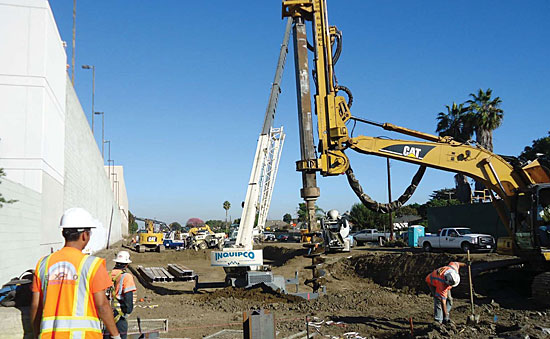
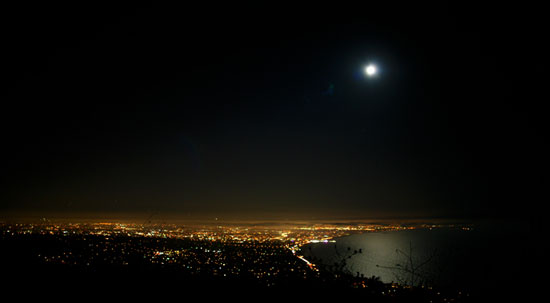

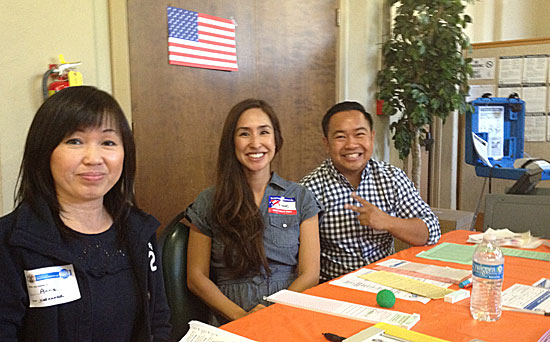
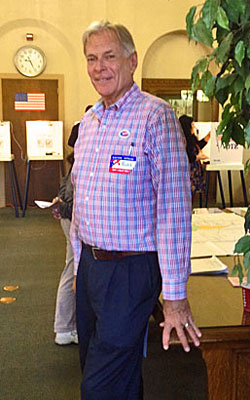
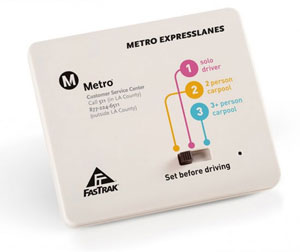





 Check for the latest closure information
Check for the latest closure information








